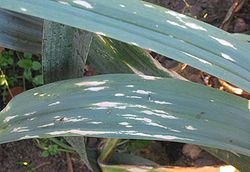- Hétérokontophytes
-
Stramenopiles
Straménopiles

Phytophthora porri sur une feuille
de poireau (Allium porrum)Classification classique Domaine Eukaryota Division Stramenopiles
(D.J.Patt., 1989)Synonymes - Straminopiles (forme corrigée)
- Stramenopila E.E.Ruppert et al., 2004
- Heterokonta
Taxons de rang inférieur - Voir texte
Position phylogénétique Eukaryota : - Apusozoa
- Excavata
- Plantae
- Chromalveolata s.l.
- Cryptophyta
- Haptophyta
- « SAR »
Groupe frère : Rhizaria Parcourez la microbiologie sur Wikipédia : Les straménopiles (en latin, Stramenopiles du latin stramen, straminis et pilus : organismes à « pelage » en forme de « feuillage ») ou hétérocontes (Heterokonta : « à flagelles différents ») constituent un sous-règne des eucaryotes.
Ils sont caractérisés par l'existence, au cours de leur cycle, d'une cellule biflagellée avec deux flagelles différents : un flagelle lisse est un flagelle plumeux à mastigonèmes tubulaires tripartites.
Seuls les Ochrophyta sont photosynthétiques ce qui explique qu'ils étaient autrefois classés parmi les algues. Les lignées ayant divergé le plus anciennement, comme les oomycètes, étaient autrefois classés comme champignons et d'autres encore étaient classés dans les protistes.
Sommaire
Taxons de rang inférieur
- Groupes hétérotrophes
- Blastocystae
- Proteromonadea
- Opalinidea
- Bicoecea
- Labyrinthulomycetes
- Oomycetes
- Hyphochytridiomycetes
- Bigyromonadea
- Groupes autotrophes (Heterokontophyta ou Ochrophyta)
- Pinguiophyceae
- Bacillariophyta
- Bolidophyceae
- Parmophyceae
- Pelagophyceae s.l.
- Pedillenophyceae s.l.
- Raphidophyceae
- Phaeothamniophyceae
- Chrysomerophyceae
- Xanthophyceae
- Schizocladiophyceae
- Phaeophyceae
- Eustigmatophyceae
- Chrysophyceae
Étymologie
L'origine du terme straménopile est explicitée dans le passage suivant de Adl et al. (2005)[1] :
"Regarding the spelling of stramenopile, it was originally spelled stramenopile. The Latin word for ‘‘straw’’ is stramine-us, -a, -um, adj. [stramen], made of straw—thus, it should have been spelled straminopile. However, Patterson (1989)[2] clearly stated that this is a common name (hence, lower case, not capitalized) and as a common name, it can be spelled as Patterson chooses. If he had stipulated that the name was a formal name, governed by rules of nomenclature, then his spelling would have been an orthogonal mutation and one would simply correct the spelling in subsequent publications (e.g. Straminopiles). But, it was not Patterson’s desire to use the term in a formal sense. Thus, if we use it in a formal sense, it must be formally described (and in addition, in Latin, if it is to be used botanically). However, and here is the strange part of this, many people liked the name, but wanted it to be used formally. So they capitalized the first letter, and made it Stramenopiles; others corrected the Latin spelling to Straminopiles."
Références
Liens externes
- Référence NCBI : stramenopiles (en)
Catégorie : Heterokonta
Wikimedia Foundation. 2010.
